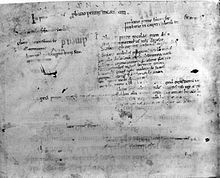Hebban olla vogala


"Hebban olla vogala", sometimes spelled "hebban olla uogala", are the first three words of an 11th-century text fragment written in
An often-cited poem, it was long believed by many Dutch-speakers to be the only remaining text in Old Dutch. However, experts were already aware of other sources that were then not yet easily accessible. Today, more than 42,000 Old Dutch words and phrases from sources such as the
Text
The complete text, a
Origin
The text was long considered
The debate regarding the text's language, however, was reopened in 2004, when Luc De Grauwe asserted that many of the text's forms could also reflect the Kentish dialect of Old English.[8] It has particularly been pointed out that the -s plural of nestas, the verb aginnan and the ending on -e of hinase are in fact more typical of Old English.[5] The emerging consensus view is that the text is a linguistic blend of Old Dutch and Old English; it may even reflect a Flemish-speaking scribe's attempt at writing in English, making it not only a probatio pennae, or pen trial, but also a "probatio linguae", or language trial.[9]
Language comparisons
Kenny Louwen gives a comparison of different forms the sentence would be expected to take in Old Dutch, Old English and Middle Dutch, which highlights the linguistic influences the text as it survives in the manuscript. (He reads umbidan rather than unbidan.)[5]
| Manuscript text | Hebban | olla | uogala | nestas | hagunnan | hinase | hic | enda | thu | uuat | umbidan | uue | nu |
| Old Dutch | Hebban(t) | alla | uogala | nest(a) | bigunnan | hit ne sē | (h)ic | enda | thu | uuat | umbidan(t) | uue | nu |
| Old English | Habbað | ealle | fuglas | nestas | agunnen | hit ne sē | (h)ic | and | þu | hwæt | onbīdað | we | nu |
| Middle Dutch | Hebben | olle | uogele | neste | begonnen | hit en sē | (h)ic | ende | du | wat | ombiden | we | nu |
Below is a comparison of the manuscript text with its closest translations into modern Dutch and English. The Dutch sentence is a correct one, although the verb begonnen is usually conjugated with zijn (be) and not with hebben (have). For English the word order had to be adjusted. For hinase and unbidan there are no close matches in either language.
| Manuscript text | Hebban | olla | uogala | nestas | hagunnan | hinase | hic | enda | thu | uuat | unbidan | uue | nu |
| Dutch | Hebben | alle | vogels | nesten | begonnen | (behalve) | ik | (ende)/en | u/jij | wat | (ver)beiden | we | nu? |
| English | Have | all | fowls (birds) | nests | begun | (except) | I | and | thou | what | bide (= are waiting for) | we | now? |
The form hinase corresponds morphologically to Modern Dutch tenzij, meaning "unless", from hit ne sī, Modern Dutch het niet zij, literally "it were not to be".[10] It does not seem to have a Modern English cognate.
Various theories

Frits van Oostrom has linked it to the Moorish Kharjas genre, which includes verses sung by women to their absent lovers. He concludes that the fragment was probably written by a woman or from a female perspective.[11]
See also
- Gruuthuse manuscript
- History of Dutch
References
- JSTOR 508633.
- ISSN 0040-7550.
- ^ van Houts, Elisabeth (2006). "Contrasts and interaction. Neighbours of nascent Dutch writing: the English, Normans and Flemish (c. 1000–c. 1200)". Queeste. Tijdschrift over middeleeuwse letterkunde in de Nederlanden. 13: 3–11.
- ISSN 0143-4632.
- ^ .
- ISSN 1865-9403.
- ^ Schönfeld, M. (1933). "Een Oudnederlandsche zin uit de elfde eeuw (met reproduktie)". Tijdschrift voor Nederlandsche Taal- en Letterkunde (in Dutch). 8: 1–8.
- ^ de Grauwe, Luc (2004). "Zijn olla vogala Vlaams, of zit de Nederlandse filologie met een koekoeksei in (haar) nest(en)?". Tijdschrift voor Nederlandse Taal- en Letterkunde (in Dutch). 120: 44–56.
- ^ Dekeyser, Xavier (2007). ""Hebban olla vogala nestas hagunnan": Een Vroegnederlands kroonjuweel of een mythe?". In Sandra, Dominiek; Rymenans, Rita; Cuvelier, Pol; Van Petegem, Peter (eds.). Tussen taal, spelling en onderwijs: essays bij het emeritaat van Frans Daems (in Dutch). Ghent: Academia Press. pp. 117–26.
- ^ INL, Oudnederlands Woordenboek, s.v. hitnesī ([1]).
- OCLC 71644657.
